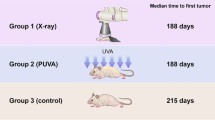Abstract
The influence of repeated low-dose ultraviolet B (UVB) radiation, to which we are exposed in daily life, has not been fully clarified, although the damage caused by exposure to high-dose UVB radiation has been well-studied in recent years. To investigate skin damage caused by repeated low-dose exposure, we evaluated the extent of injury to the Langerhans cells which are known to be involved in the cutaneous immune system. The backs of hairless mice were exposed to the following doses of UVB radiation: 100 mJ/cm2 once, 50 mJ/cm2 twice, 25 mJ/cm2 four times or 10 mJ/cm2 ten times. Skin specimens were taken for histochemical and electron microscopic examination 24 h after the final irradiation. Epidermis exposed to UVB radiation demonstrated a decrease in the number of Langerhans cells which showed less dendricity. The population of these cells in specimens exposed to repeated suberythemal doses was reduced to 40%, whereas exposure to a single high dose of UVB with the same energy resulted in a reduction of only 33%. These results indicate that repeated suberythemal doses injure Langerhans cells more than a single high-dose exposure. Furthermore, Birbeck granules in Langerhans cells of UVB-irradiated epidermis were reduced and tended to show shortening of their rod portion. The present study suggested that repeated challenge with suberythemal UVB radiation, to which we are all exposed in daily life, can cause substantial damage to Langerhans cells.



Similar content being viewed by others
References
Aberer W, Schuler G, Stingl G, Honigsmann H, Wolff K (1981) Ultraviolet light depletes surface markers of Langerhans cells. J Invest Dermatol 76:202–210
Bergstresser PR, Toews GB, Streilein JW (1980) Natural and perturbed distributions of Langerhans cells: responses to ultraviolet light, heterotopic skin grafting, and dinitrofluorobenzene sensitization. J Invest Dermatol 75:73–77
Bissett DL, Hannon DP, Orr TV (1987) An animal model of solar-aged skin: histological, physical, and visible changes in UV-irradiated hairless mouse skin. Photochem Photobiol 46:367–378
Cumberbatch M, Dearman RJ, Kimber I (1997) Interleukin 1 beta and the stimulation of Langerhans cell migration: comparisons with tumour necrosis factor alpha. Arch Dermatol Res 289:277–284
Hart PH, Grimbaldeston MA, Swift GJ, Sedgwick JD, Korner H, Finlay-Jones JJ (1998) TNF modulates susceptibility to UVB-induced systemic immunomudulation in mice by effects on dermal mast cell prevalence. Eur J Immunol 28:2893–2901
Hattori Y, Nishigori C, Tanaka T, Uchida K, Nikaido O, Osawa T, Hiai H, Imamura S, Toyokuni S (1996) 8-Hydroxy-2′-deoxyguanosine is increased in epidermal cells of hairless mice after chronic ultraviolet B exposure. J Invest Dermatol 107:733–737
Ho KK, Halliday GM, Barnetson RS (1992) Sunscreens protect epidermal Langerhans cells and Thy-1+ cells but not local contact sensitization from the effects of ultraviolet light. J Invest Dermatol 98:720–724
Jimbo T, Ichihashi M, Mishima Y, Fujiwara Y (1992) Role of excision repair in UVB-induced depletion and recovery of human epidermal Langerhans cells. Arch Dermatol 128:61–67
Koh HK, Kligler BE, Lew RA (1990) Sunlight and cutaneous malignant melanoma: evidence for and against causation. Photochem Photobiol 51:765–779
Mackenzie IC, Squier CA (1975) Cytochemical identification of ATPase-positive Langerhans cells in EDTA-separated sheets of mouse epidermis. Br J Dermatol 92:523–533
Miyauchi H, Horio T (1995) Ultraviolet B-induced local immunosuppression of contact hypersensitivity is modulated by ultraviolet irradiation and hapten application. J Invest Dermatol 104:364–369
Murphy GM, Norris PG, Young AR, Corbett MF, Hawk JL (1993) Low-dose ultraviolet-B irradiation depletes human epidermal Langerhans cells. Br J Dermatol 129:674–677
Nair X, Tramposch KM (1989) UVB-induced pigmentation in hairless mice as an in vivo assay for topical skin-depigmenting activity. Skin Pharmacol 2:187–197
Steinbrink K, Kolde G, Sorg C, Macher E (1996) Induction of low zone tolerance to contact allergens in mice does not require functional Langerhans cells. J Invest Dermatol 107:243–247
Ullrich SE (1994) Mechanism involved in the systemic suppression of antigen-presenting cell function by UV irradiation. Keratinocyte-derived IL-10 modulates antigen-presenting cell function of splenic adherent cells. J Immunol 152:3410–3416
Vermeer M, Streilein JW (1990) Ultraviolet B light-induced alterations in epidermal Langerhans cells are mediated in part by tumor necrosis factor-alpha. Photodermatol Photoimmunol Photomed 7:258–265
Walker SL, Young AR (1997) Sunscreens offer the same UVB protection factors for inflammation and immunosuppression in the mouse. J Invest Dermatol 108:133–138
Wolff K (1983) The Langerhans cell and the epidermis. J Dermatol 10:401–410
Yoshikawa T, Rae V, Bruins-Slot W, van den Berg JW, Taylor JR, Streilein JW (1990) Susceptibility to effects of UVB radiation on induction of contact hypersensitivity as a risk factor for skin cancer in humans. J Invest Dermatol 95:530–536
Acknowledgements
The authors thank Dr. Hironori Niizeki, Department of Dermatology, Nara Medical University, for his excellent technical advice.
Author information
Authors and Affiliations
Corresponding author
Rights and permissions
About this article
Cite this article
Ishitsuka, Y., Masunaga, T., Koide, C. et al. Repeated irradiation with suberythemal ultraviolet B reduces the number of epidermal Langerhans cells. Arch Dermatol Res 295, 155–159 (2003). https://doi.org/10.1007/s00403-003-0397-4
Published:
Issue Date:
DOI: https://doi.org/10.1007/s00403-003-0397-4




